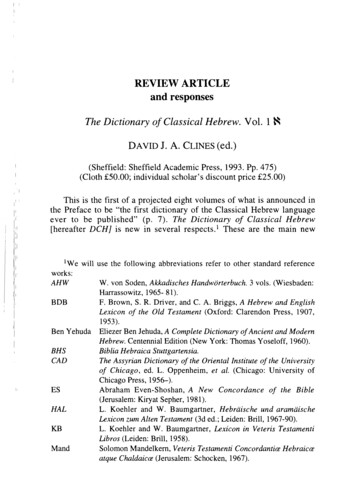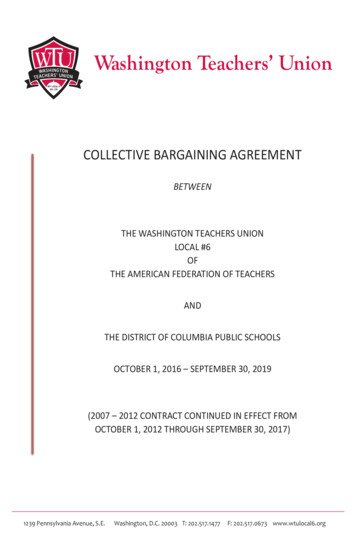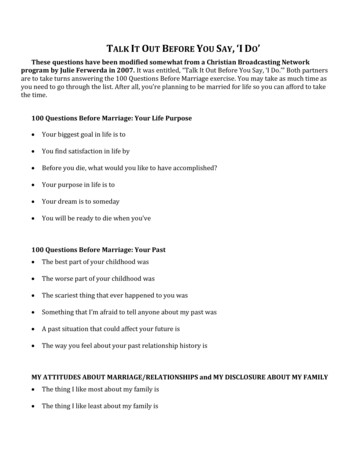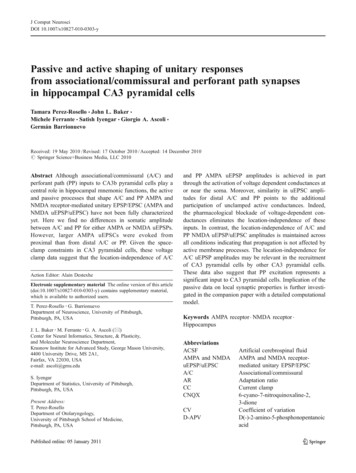
Transcription
REVIEW ARTICLEand responsesThe Dictionary of Classical Hebrew. Vol. 1 DAVID J. A. CUNES (ed.)(Sheffield: Sheffield Academic Press, 1993. Pp. 475)(Cloth 50.00; individual scholar's discount price 25.00)This is the first of a projected eight volumes of what is announced inthe Preface to be "the first dictionary of the Classical Hebrew languageever to be published" (p. 7). The Dictionary of Classical Hebrew[hereafter DCH] is new in several respects.l These are the main new1Wewill use the following abbreviations refer to other standard referenceworks:AHWBDBBen YehudaBHSCADESHALKBMandW. von Soden, Akkadisches Handworterbuch. 3 vols. (Wiesbaden:Harrassowitz, 1965- 81).F. Brown, S. R. Driver, and C. A. Briggs, A Hebrew and EnglishLexicon of the Old Testament (Oxford: Clarendon Press, 1907,1953).Eliezer Ben Jehuda, A Complete Dictionary of Ancient and ModemHebrew. Centennial Edition (New York: Thomas Yoseloff, 1960).Biblia Hebraica Stuttgartensia.The Assyrian Dictionary of the Oriental Institute of the Universityof Chicago, ed. L. Oppenheim, et al. (Chicago: University ofChicago Press, 1956-).Abraham Even-Shoshan, A New Concordance of the Bible(Jerusalem: Kiryat Sepher, 1981).L. Koehler and W. Baumgartner, Hebriiische und aramiiischeLexicon zum Alten Testament (3d ed.; Leiden: Brill, 1967-90).L. Koehler and W. Baumgartner, Lexicon in Veteris TestamentiLibros (Leiden: Brill, 1958).Solomon Mandelkem, Veteris Testamenti Concordantice Hebraicceatque Chaldaicce (Jerusalem: Schocken, 1967).
Andersen: Review Article51features. (i) It includes as the corpus of "Classical Hebrew" the text of theHebrew Bible, inscriptions from biblical times, Hebrew ben Sirach, andQurnran texts in Hebrew. (ii) It lists the use of each item with other itemsin terms of syntactic constructions and idiomatic and rhetorical co-occurrences. Thus it lists the subject, objects, etc., of verbs. It lists the verbs thata noun is the subject or object of. It lists nouns in construct or appositionwith the noun under study as well as its attributive adjectives. (iii) Lists ofsynonyms are given at the end of each entry. (iv) At the end of the volumeis an index of English glosses, an amenity in the old Tregelles Englishedition of Gesenius' Lexicon (1846), but dropped from BDB.The Introduction includes The Recent History of Hebrew Lexicography. KB (HAL) is the only major project discussed. The impressive workof Zorell is not mentioned. Yet it is always worth consulting. Zorellreflects progress made since BOB; for example, he is aware of therecovery of the G passive for many verbs. Thus he correctly reports j 1'(yuJiir: Num 22:6) as Gpas (Zorell 82b); DCH continues to classify itincorrectly as Ho. (p. 398). Nor does the review of history mention themagisterial work of Ben Yehudah, an indispensable treasury for theserious student of Hebrew lexicography.***In March 1972 a colloquium on Semitic Lexicography was held inFlorence. 2 J ames Barr presented a paper on "Hebrew Lexicography."3Barr laid down the guide lines for Hebrew lexicography in keeping withmodern linguistics. In 1987 Barr once more addressed the topic, now inRSPRas Shamra Parallels (AnOr 49-51; Rome: Pontifical BiblicalInstitute, 1972-81).TDOTTheological Dictionary of the Old Testament. 6 vols., ed. G. J.Botterweck and H. Ringgren (Grand Rapids: Eerdmans, 1974-90).TWOTTheological Wordbook of the Old Testament. 2 vols., ed. R. LairdHarris, Gleason L. Archer, Jr., and Bruce K. Waltke (Chicago:Moody, 1980).Max Wagner, Die lexicalischen und grammatikalischenWagnerAramaismen im alttestamentlichen Hebriiisch. BZAW 96 (Berlin:Alfred T6pelmann, 1966).ZorellFranciscus Zorell, Lexicon Hebraicum Veteris Testamenti (Rome:Pontifical Biblical Institute, 1984).2Pelio Fronzaroli, ed., Studies on Semitic Lexicography. Quaderni diSernitistica 2 (Florence: Istituto di Linguistica e di Lingue Orientali, Universita diFirenze, 1973).3Fronzaroli, Studies, 103-26. Hereafter, Barr, "Hebrew Lexicography"-1973.
52AUSTRALIAN BIBLICAL REVIEW 43/1995the light of his experience as editor of the Oxford Hebrew Lexicon. 4 Themakers of DCH claim that "unlike previous dictionaries, DCH has atheoretical base in modern linguistics" (p. 14). That claim can be studiedby placing DCH alongside Barr's recommendations.1. THE HISTORICAL COMPONENT OF HEBREW VOCABULARYBaIT discusses the desirability of tracking the history of Hebrew wordmeanings. 5 This requires tagging their occurrence, not only in early or latebooks, but (especially with the Pentateuch) identifying the sources (l, E,D, P) as indicators of the relative age of use. "The task of the lexicographer cannot therefore be entirely separated from involvement in certainquestions that are historical rather than directly linguistic".6DCH explicitly eschews this task. It "studies the classical Hebrewlanguage as if it were a synchronic system . we regard the classicallanguage as constituting a single phase in the history of the Hebrewlanguage" (p. 16 [italics ours]). DCH professes to be not interested in thedevelopment of word meanings in any period. By treating the corpus "as ifit were a synchronic system" (p. 16) DCH either assumes that there wereno changes over time worth reporting in the lexicon, or that any suchchanges cannot be detected, or that the users can work that out for themselves.The assumption that we have here "a single phase in the history of theHebrew language" (p. 16) amenable to treatment "as if it were asynchronic system" (p. 16) is so patently false that the results of thishomogenization are inevitably flawed. The language, including the lexicalcomponent, of the chosen texts is far from uniform. Apart from historicalchanges over such a long period of time, there are dialectal variations,even within the Hebrew Bible 7 . On the basis of dialect geography, texts inthe language conventionally called "Moabite" are less divergent from"classical Hebrew" than some portions of the Bible (e.g., Qoheleth, Songof Songs). Ben Sirach was still writing bravely in "biblical" Hebrew, butthe Dead Sea Scrolls are another matter, particularly in the area of lexicon.To suppose that the use of a word at Qurnran at the turn of the era can be4James Barr, "Hebrew Lexicography: Informal Thoughts," pp. 137-151 inLinguistics and Biblical Hebrew, ed. WaIter R. Bodine (Winona Lake:Eisenbrauns, 1992); hereafter, "Hebrew Lexicography"-1992. See also W. C.van Wyk, "The present state of OT lexicography," pp. 82-96 in Lexicography andTranslation, ed. J. P. Louw (Cape Town: Bible Society of South Africa, 1985).5Barr, "Hebrew Lexicography"-1992, 148.6Barr, "Hebrew Lexicography"-1973, 106.7Ian Young, Diversity in Pre-Exilic Hebrew. Forschungen zum AltenTestament 5 (Tiibingen: Mohr, 1993).
Andersen: Review Article53placed alongside its use in the time of David, a thousand years earlier, islike saying that the meaning of an English word in the twentieth centurygives us the meaning it had for Chaucer, or even King Alfred.This is not the way dictionaries are being made nowadays for anycorpus of classical texts that we know of. CAD is careful to report where,and if possible when, each reported attestation of use of a dictionary itemoccurs. 1. I. Sreznevsky's monumental Materials for the Dictionary of theOld Russian Language (St. Petersburg, 1893-1903) was flawed by lack ofhistorical perspective and insensitivity to regional differences in usage. Itis now superseded by dictionaries that control both these parameters.There are separate reference works for Old Ukrainian, Old Russian 8 andOld Slavic 9 . These works are careful to list separately the attestations ineach subcorpus, with dates when possible.The inclusion of material from LXX in the old Liddell and Scott Greeklexicon was an amenity much appreciated by Bible students. Its reductionin the current edition avoids the false impression that biblical Greek is"classical." It is no longer possible to lump all ancient Greek together forsynchronic description. A separate dictionary is needed for Koine, andeven for its major corpora-the papyri, LXXIO (even a part of it, as inMuraoka's exemplary work ii ), early Christian Greek (Bauer), Philo,Josephus, Patristic Greek (Lampe), Byzantine Greek, and so on. All thismaterial could be assembled in one gigantic dictionary, of course. But tohomogenize it!To study any such corpus of historical texts synchronically can benothing better than a makeshift, for want of knowledge of dates for muchof the material. To invoke modern linguistics as warranting such a policyis a subterfuge. It is ironic for this to be happening in Hebrew lexicography at the very time when historical linguistics is enjoying a comebackwith the realization that even in one generation the heterogeneous usage8C. D. Barkhudarov (ed.), Dictionary of the Russian Language XI-XVI!Century (Moscow: Sciences, 1975-).9Josef Kurz, Slovnik Jazyka Staroslovenskeho (Praha: Academia, 1966-).IOJohan Lust, E. Eynike1, and K. Hauspie, eds., A Greek-English Lexicon ofthe Septuagint (Stuttgart: Deutsche Bibe1gesellschaft, 1992).iiTakamitsu Muraoka, A Greek-English Lexicon of the Septuagint. TwelveProphets. (Louvain: Peeters, 1993). See also the important methodologicaldiscussions in idem, "Towards a Septuagint Lexicon," VI Congress of theInternational Organization for Septuagint and Cognate Studies, Jerusalem 1986(Atlanta, GA: Scholars Press, 1986); Melbourne Symposium on SeptuagintLexicography. SBLSCS 28 (Atlanta, GA: Scholars Press, 1990).
54AUSTRALIAN BIBLICAL REVIEW 43/1995reflects the time-driven evolution of the language.12 The old hangs on,particularly when a prestigious traditional literature retains its influence.The new emerges only partially. The data resist the inductive method.How much more, then, when the time period could be a thousand years!While it is true that "the holding together of this wide span of linguistic change is appropriate"13 , to ignore the changes that undoubtedly tookplace in classical Hebrew over the thousand years of use recognized byDCH is irresponsible.For this kind of information, e.g., the occurrence of a lexical item inthe sources of the Pentateuch (1, E, D, P, etc.), however provisional ordisputable, the student will find that the tagging in BDB is still useful.More recently Andersen and Forbes have supplied these assignmentsexhaustively in their Vocabulary of the Old Testament (Rome: PontificalBiblical Institute, 1989).Sometimes the distinctiveness of late classical Hebrew vocabulary isevident in an entry. Of ten instances of i111 Cora; the specimen in Isa26: 19 is dubious I4 ), seven, all meaning spiritual illumination, are inQumran texts. Incidentally, another instance-i1II ' i1 I:J nil(11 QPsaDavComp 27 4 )-is not reported; it provides the important «SYN»i1 I:J .152. THE CORPUSBarr defined the scope of what he called "classical Hebrew"16 as theHebrew Bible, inscriptions of biblical times, Hebrew Sirach, and the DeadSea Scrolls. DCH follows Barr's prescription. Barr went on to say that"the lexicography of old Hebrew needs to develop adequate contacts withMiddle Hebrew; some indication must be given of the direction in whichthe word or words in question were already developing in the centuriesabout the turn of the era". 1712Roman Jakobson, doyen of modern linguists, pointed out that "theachievements of the synchronic concept force us to reconsider the principles ofdiachrony as well. . Pure synchronism now proves to be an illusion: everysynchronic system has its past and its future as inseparable structural elements ofthe system" (Language in Literature, Krystyna Pomorska and Stephen Rudy, eds.[Cambridge, MA: The Belknap Press of Harvard University Press, 1987] 48).13Barr, "Hebrew Lexicography"-1973, 109.14Day, John, "mi' ' in Isaiah 26:19," ZAW90 (1978) 265-69.15Professor Andersen's MS. often vocalized the Hebrew; because AusBR doesnot use vocalized Hebrew, a transliteration is added where needed (ed.).16"Hebrew Lexicography"-1973, 110; "Hebrew Lexicography"-1992, 138.17Barr, "Hebrew Lexicography"-1973, Ill.
Andersen: Review Article55For the Hebrew Bible DCH takes BHS, virtually the Leningrad Codex(L) of 1009 CE, as its standard. But BHS has not always been followed.The entry for i1rJ eumma; p. 312) misses the additional places where thisword occurs in BHS, following L (Pss 44: 15; 57: 10; 108:4; 149:7). Theketib / qere apparatus of BHS cannot be considered authoritative.A mirage is created by putting together the fully pointed Hebrew Bibleas found in BHS with texts a thousand years older or more that surviveonly in consonantal orthography. It is not the classical language of biblicaltimes that is being studied, but a massive overlay of mediaeval tradition,which is plastered over the non-biblical texts as well. How, for instance,do we know how to point p ? How do we know, from its one attestationin the corpus, that it means sighing, and does not have, say, one of themeanings that this word has in later Hebrew according to Ben Yehuda?3. SEMITIC ROOTS AND COGNATESOn p. 24 DCH refers to the discovery of Ugaritic as one reason for updating Hebrew lexicography. At the same time DCH asserts that evidencefrom possible cognates in other Semitic languages is, theoretically,"strictly irrelevant to the Hebrew language" (p. 17) and complains that,practically, "the significance of the cognates has been systematicallymisunderstood by many users of the traditional dictionaries."How then should a dictionary handle information from outside thechosen corpus? Besides culturally related texts from before and during theclassical period, there is also "the testimony of ancient versions" and"Jewish lexicographical and exegetical tradition" (p. 18). "It is a cardinalerror in principle to seek to isolate the biblical language from laterHebrew".18 How then does DCH know the meanings of so many wordswhose meagre attestation in the chosen texts of classical Hebrew gives solittle evidence of "use in the language" that only the vaguest notion ofpossible meaning can be gained by a linguistic method that disqualifiesthe use of comparative philology?Nobody knows the pitfalls of comparative philology better than JamesBarr, and nobody has exposed the rubbish of the subject more remorselessly than he has done. This background makes his judicious remarks allthe more telling. "We do not have the sort of knowledge of many terms inBiblical Hebrew that can stand on its own as a purely intra-hebraic matter,to be taken in total indifference to other Semitic languages. We have toaccept that, for us in our situation, our perception of Hebrew words andtheir meanings is linked with comparative-philological and historical-18Barr, "Hebrew Lexicography"-1973. 103.
56AUSTRALIAN BIBLICAL REVIEW 43/1995philological perceptions"19 Van Wyk says, "Old Testament lexicographyis inconceivable without its comparative Semitic context" (Louw 89)."This fact [comparative philology] has to be taken into account by thelinguist of today".2o The use of comparative philology to identify "new"meanings for Hebrew words has, in this century "become a major industry".21 "The full indexing of all this material has become a major task forthe lexicographer". 22Notwithstanding the mention of Ugaritic, DCH disavows the use ofcomparative data. There are no explicit references to other languages; yetthe results of comparative-philological research are everywhere accepted.How does DCH know that i1' ( asyfi; hapax in Jer 50: 15) is a tower?KB says "pillar," citing cognates. Ben Yehuda says "base." TWOT"buttress." The comparative evidence is summarized by Wagner (p. 30).How else could DCH possibly know that ,'; attested only once(Joel 1:8) means mourn, and not, say curse? From the cognate inAramaic (disqualified by DCH)? Because it fits the context? A flimsyargument that can only support an argument based on something firmer.We are left with an oblique hint from LXX 8pllvllCJov (BDB). And that isonly half the story. BDB did not report that LXX reads 8pllvllCJov TTp0S'IlE, with TTp0S' IlE matching ,'; . This leaves 8PllvllCJov unexplained, and,'; along with it.How can it be inferred from one attestation that ';:n eabiil) mightmean tower (p. 148) rather than the usual river? The knowledge that i1:l ( ebeh; Job 9:26) means reed is not the result of fresh study of use,unprejudiced by tradition. It is traditional; but the recognition of cognatesconfirms it. (BDB abu has to be corrected to apu [KB; CAD 1 A II: 199;AHW 62], and the Mesopotamian connection makes "papyrus" lesscertain.)On what basis does one propose twilight as the sense of ( eme'S) atJob 30:3? If Arabic be permitted to supply a clue (God forfend!), Jamsmeans "yesterday" or "last night." If the proposal is not to be dismissed asmerely ad hoc, it needs to be shown that the sinister associations of thefollowing words betray the literary motif of night as danger and twilight asan especially ominous time. In reaching this conclusion, comparativephilology joins forces with comparative literature and exegesis.The fact that "the significance of the cognates has been systematicallymisunderstood by many users of the traditional dictionaries" (pp. 17-18) isnot a reason for withholding information about cognates. Even if much ofelm,19Barr, "Hebrew Lexicography"-1992,2oBarr, "Hebrew Lexicography"-1973,21Barr, "Hebrew Lexicography"-1973,22Barr, "Hebrew Lexicography"-1973,142.107.116.116.
Andersen: Review Article57this work has been done badly and many of the proposed meanings are notconvincing enough to make their way into a standard dictionary, theremedy for bad work is not no work but good work. If users are to judgefor themselves, the least they can expect from a dictionary is a reporting ofthe options, with pointers to the technical literature where the proposalsare discussed. Here HAL is indispensable. Disciplined by sound method,the sober study of cognates is a legitimate part of lexicography, andstudents of classical Hebrew will be grateful for dictionaries that supplythat kind of information. BDB is regrettably out of date in this matter; butthe remedy is to replace it with something more reliable. The remedy forsystematic misunderstanding of cognates is valid understanding arisingfrom rigorous methodology. In this regard DCH is outclassed by HAL.4. DERIVATIONSDCH has cross-references based on common roots. It insists, nevertheless,that there are "no historical implications" (p. 21); it is "not concerned withthe etymology of words" (p. 22). It is not so easy to escape from history.DCH has liberated itself from the mystique of the Semitic root onlypartially. While other words are ordered simply by their conventionalspelling, and all derivatives of the same root are treated as lexical items intheir own right, the treatment of the verb is still controlled by the supposedcommon root of the several stem formations, even when modern descriptive method would require the recognition of the lexicalization of thebinyiinfm.DCH lists verbs by traditional three-consonant roots, even when thereis no evidence for the existence of such entities.The sole use of "n ni1 in Ezek 21 :21 can hardly yield the knowledgethat it means be united (DCH 179). The proposal is the outcome ofetymologizing (supposedly banned in modern lexicography), recognizingthe root 'n as the same as the root of the numeral "one." That may belegitimate. But such a move subverts the stated policy of DCH. It usesold-fashioned "derivation." There is only a difference in degree, not inprinciple, between using the evidence of a postulated cognate withinHebrew and resorting to a cognate now attested only in some otherSemitic language.We know from the three occurrences of O':J eebus) and the twooccurrences of O':J eiibus) that they have something to do with domesticated animals (and perhaps with each other, if roots can be usedetymologically). But how can we narrow the possibilities to trough orstall (fatten or keep in stall)?Derivation rather than use as an ordering principle is implied by thecross-references. Behind the link between i1rJ' eiidama) and t:J, (p. 132)is the old notion that "earth" is "red." The supply of i1:l eoneh; p. 333) as
58AUSTRALIAN BIBLICAL REVIEW 43/1995the (unattested) lemma for three words meaning distress depends on thesupposition that the root is ·m , as the cross-reference shows. This identification does not do justice to the feature that the stem vowel is alwaysplene, making it hard to justify the segregation of these instances from ]1 eawen) misfortune (p. 154). Etymology is still evident in the inclusion of:l':l ear (of cereal) and (month of) Abib in one entry. Modern dictionariesthat are more descriptive tend to recognize the lexicalization of suchforms, and list them separately or at least distinctly in subentries.5. BORROWINGSNot only does classical Hebrew contain many words with cognates inother Semitic languages; it has borrowed words from other languages.They might not always preserve their original meaning, but as Barr says,"we can separate off the case of loanwords, words adopted into Hebrewfrom another language, whether Semitic or not Semitic. Where these arerecognized they should be clearly marked as such [italics added]; attentionshould be drawn to the sense in the original language . . . and to theprobable period of adoption". 23If we knew only its one occurrence in Dan 11 :45, how could we workout that ]i Cappeden) means palace? From extensive attestation in otherlanguages (Wagner 28) the identity of the word as a loan is established,and there is no reason why we should not be told that, since that is how weknow that means "pavilion" or the like.What is the basis for the declaration of palanquin as the only candidate for the meaning of the hapax ]1" eappiryon; p. 361)? The usersneed a lot more data before they can make their own judgment. At thevery least it would be helpful to be told where a problem like this isdiscussed in detail (in this case, Pope's generous discussion in AnchorBible: Song of Songs pp. 441-42).6. TRADITIONAL KNOWLEDGE OF WORD MEANINGSIn Hebrew lexicography, extensive use is made of clues provided by otherancient languages, by ancient translations into Greek or Aramaic, by theknowledge of meanings preserved in the Jewish community and nowavailable in the writings of the rabbis. As Barr says: "The meaning of aword in the immediate postbiblical period can help us to estimate how farthe traditions of its biblical meaning may on the one hand be genuine andgo back to actual senses in usage, and how far on the other hand they23Barr, "Hebrew Lexicography"-1973, 113.
Andersen: Review Article59derive from popular etymology, religious interpretation, and generalguesswork". 24There is no need to claim that the rabbis had a scientific knowledge ofthe historical dialectology of classical Hebrew in order to make use of theknowledge of the usage of Hebrew vocabulary that came down in theJewish community. Robert Gordis pointed out more than once that biblicallexicography had failed to exploit the rabbinic writings as a rich source ofevidence of the use of biblical vocabulary. Due caution is always needed,of course. The possibility of anachronism can never be ruled out. The(mis)understanding of an old word by giving it its current meaning goeson all the time. It can be seen in the way Qumran texts use biblical words.This is why a dictionary of one thousand years of a language should workout, not only what a word meant, but also when it meant it. The culturalgap between the Bible and the rabbis is no greater than, for instance, thepre-exilic texts and Qumran.An illustration from the Masoretic text of 1 Sam 21 :9: i1EnV' r eiynyes poh). r is a hapax in the Bible. Manuscripts show that the scribescould not protect this word from being gobbled up by the ubiquitous r eaiyn), as it is in DCH (pp. 217, 220). Assuming that it should be r C'aiyn), the text is cast aside as "unintelligible"25 The context suggests thatDavid is asking a question, and various emendations have been proposedto turn the Hebrew text into some textbook form of interrogation. Gordishas pointed to the evidence that r ( 'in) is a real word, an interrogativeparticle. 26 The fact that a claim such as this falls short of proof does notmean that it should be disdained. Very few such discussions supply thecertainty that we would like to have in these matters.7. LEMMATIZATIONDCH has no settled policy when it comes to lemmatization. 27 When aretwo or more items that are different in form but similar in meaning to bejoined as "the same" under one lemma? Should "O easslr) and "O eiislr); ":l eabblr) and ":l eiiblr) be one entry each pair (as in ES) or24Barr, "Hebrew Lexicography"-1973, 111-12.25p. Kyle McCarter, I Samuel (AB 8; New York: Doubleday, 1980) 348.26Robert Gordis, "Studies in the Relationship of Biblical and RabbinicHebrew," L. Ginzberg Jubilee Volume, 1946, pp. 173-200; reprinted in The Wordand the Book: Studies in Biblical Language and Literature (New York: KTAV,1976) 158-184 (see p. 161). The entry in Ben Yehuda (I, p. 193) is also worthstudying.27Prancis I. Andersen and A. Dean Porbes "Problems in Taxonomy andLemmatization," Proceedings of the First International Colloquium: Bible and theComputer-The Text, (Paris-Geneva: Champion-Slatkine, 1986) 37-50.
60AUSTRALIAN BIBLICAL REVIEW 43/1995two (as in BDB, Mand)? :1:i eomniim) and m1:i eumniim) have twoentries (p. 319), but putative '1:i ( emer) and '1:i eomer) are combined (p.325). BOB (p. 57) gives i1'1:i eemrfl) its own lemma. Even though 'iD' eiS/m) is attested, DCH lists 'iD: as pI. of iD· . The empirical approach ofmodern linguistics would suggest separate lemmas. Likewise i1iD , ·iD:. Itis only by the supposition of a common etymology (implied by the crossreference to ,, ) that four words i1" Ciigudda) are under one lemma.Lemmatization is a problem even for proper nouns. When a person hastwo names, how similar do they have to be to be put in one entry(i1:" /p' )? How different to be put into two (Cl1:J IcJi1':J )?And, contrariwise, when is a word that has, by use, distinguishablemeanings to be split into distinct entries? The older practice was to listsubmeanings in one entry if the bearers of those meanings were believedto derive from the same ancestor (the etymological fallacy) or if one was afigurative extension of the other. The problem of lexicalization of thebinyiinfm was mentioned above, under Derivation. BDB and HAL haveone lemma for the ni. and pi. of ? . DCH gives pi. its own entry (p. 294).It would be more in line with the contemporary practices of dictionarymakers to recognize each numeral as a distinct lexical item and to giveeach its own lemma, not listing "forty" with "four," for instance (a hangover of the discredited derivational approach). The technical use of Cl"n eiihijmm) meaning few deserves its own entry, by modern practice, as inAlcalay's Dictionary of Hebrew 28 .The two approaches are illustrated by the words i1'11:iiD Casmurfi) andm1:iiD easmoret). Traditional works (BOB, KB, Zorell) put them in oneentry. Works with a more descriptive approach (ES, BY) split them. DCHlinks them.The difficulty with splitting a homonym into more than one entry isthat, the greater the delicacy, the more likely that there will be equivocalcases. The word 1? ( allup) occurs sixty-nine times in the Hebrew Bible.DCH has an entry for each of the three glosses chief, cow, tame. KB hastwo. Across the reference works the attested instances are variouslyassigned to the two or three categories.The dictum "meaning is use" has led, in modern dictionary making, tothe recognition that the individual word is not always the most appropriateitem for a lexical entry. Compounds of more than one word often acquirethe status of vocabulary item, and should be listed accordingly. DCH doesthis only in the case of some proper nouns (eight names of God compounded with ? eel) and some geographical names). The word iD':J'? eelgiibTS) is attested only in composition with 'j:J (p. 271). r eaiyn) is28Reuben Alcalay, The Complete Hebrew-English Dictionary (Hartford,Conn.: Prayer Book, 1965).
Andersen: Review Article61interrogative only in r rJ, a distinct lexical item (cf. Alcalay).29 Compoundprepositions are recognized for the syntagmatic analysis, but not as lexicalentries. For compound verbs, sce below under "Synonyms."8. USE DETERMINES MEANINGThe main claim of DCH to be using modern linguistics is the dictum "themeaning of a word is its use in the language" (p. 14). The dictum"meaning is use" works only when there is ample attestation. If enforced,this ukase would greatly limit the capacity of the lexicographer to supplyglosses for rare words. It would ban the use of sources of knowledge longexploited to augment the all-too-often insufficient evidence of use in thechosen corpus itself-etymology, comparative philology, translationequivalents in ancient versions, and traditional understandings of classicalvocabulary disclosed in post-classical sources. The method stultifies workon an ancient language, such as classical Hebrew, because the accidents ofattestation leave so many words as hapax legomena. With such a smallcorpus, the number of rare words is quite large. Of the 851 entries, 427,just over half, occur three times or fewer and contribute less than one percent of the total word count. Many of these are proper nouns, so the situation is not as bad as it might seem. Even so, there are many hapax legomena about which the only thing to be said, on the basis of use in therestricted corpus (since DCH scorns the use of etymology, cognates,ancient versions, and Jewish lexicographical and exegetical tradition), isthat we cannot tell what they mean. HAL often does this. How can it beinferred, for instance, from the one dubious attestation of ]1ii) eesun) inProv. 20:20 that it is a real word, let alone that it means "beginning"?The dictum works with a living language
52 AUSTRALIAN BIBLICAL REVIEW 43/1995 the light of his experience as editor of the Oxford Hebrew Lexicon.4 The makers of DCH claim that "unlike previous dictionaries, DCH has a theoretical base











